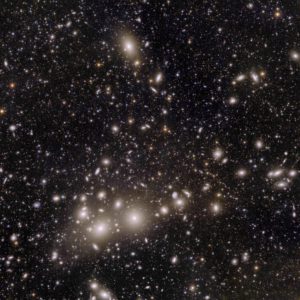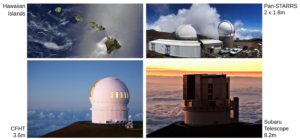S12
La science des relevés grand champ (IIIème edition)
Communauté
Contact : Raphael Gavazzi raphael.gavazzi@lam.fr

L’amas de Persée vu par Euclid (Early Release Observations)
L’astronomie grand champ entre dans une phase majeure avec l’avènement des relevés complets du ciel profond, que ce soit pour la cosmologie (arrivée des relevés de IVeme génération tels qu’Euclid, Rubin-LSST ou DESI) ou notre propre galaxies, si l’on pense notamment au succès retentissant de Gaia, lancé il y a dix 10 ans, dont la dernière release majeure a eu lieu en 2022, et dont la prochaine est attendue en 2025.
La communauté scientifique française est particulièrement mobilisée sur ces relevés à grand champ, tant en imagerie qu’en spectroscopie, et le contexte international est très pertinent pour les nombreux sujets étudiés au sein du PNCG, du PNPS et du PNP. Euclid a été lancé avec succès en juillet 2023 et le relevé principal vient de commencer pour les six prochaines années.
D’autres missions ou relevés ambitieux sont actuellement en phase d’acquisition, se concentrant sur des aspects scientifiques spécifiques et impliquent une grande partie de nos experts dans des collaborations internationales telles que DES, DECaLS, HSC, J-PAS, DESI, WEAVE, PFS, 4-MOST, etc. En particulier, les efforts menés par la France ont fourni des données sol complémentaires à Euclid dans le ciel extragalactique Nord, sous la forme du Canada-France Imaging Survey (CFIS), qui fait maintenant partie de l’effort international conjoint Ultraviolet Near-Infrared Optical Northern Survey (UNIONS) avec Pan-STARRS, et Subaru. Pristine ou VESTIGES constituent également deux efforts nationaux importants au CFHT. Ces relevés produisent désormais des résultats scientifiques d’envergure qu’il sera bon de mettre en valeur dans cet atelier.

Les télescopes d’Hawaii, contribuant au relevé UNIONS
Le positionneur de fibres de WEAVE
Un point fort de cette nouvelle édition sera Euclid. Cette réunion sera un moment idéal pour passer en revue ce projet passionnant, en particulier à la lumière des premiers résultats issus de ses « Early Release Observations », mais aussi pour s’informer sur l’avancement des projets en cours, tant en imagerie qu’en spectroscopie et s’informer sur les nouvelles données, discuter les nouvelles méthodes et verrous techniques, et évoquer les prochaines synergies et projets nouveaux pouvant émerger de la manne de données bientôt devant nous.
SOC: Herve Bouy (Univ. Bordeaux), Jean-Charles Cuillandre (Univ Paris-Saclay, CEA), Raphael Gavazzi (LAM), Vanessa Hill (OCA), Rodrigo Ibata (OAS), Yannick Mellier (IAP), Annie Robin (Obs. de Besancon), Sylvain de la Torre (LAM)
| Programme Atelier S12, mardi 4 juin | ||
|---|---|---|
| Thème 1: Relevés photométriques sol | ||
| 14:00-14:16 | Characterising a population of metal-poor stars with disc kinematics in the Milky Way with the Pristine survey at the CFHT | Isaure Gonzalez Rivera |
| 14:16-14:32 | UNIONS: 3500 deg of lensing in the Northern Sky | Fabian Hervas-Peters (invité) |
| 14:32-14:48 | Mapping the Milky Way with incomplete data | Tristan Cantat-Gaudin |
| 14:48-15:04 | Cosmology and stellar physics with strongly lensed supernovae from Rubin-LSST | Raoul Canameras |
| 15:04-15:08 | Poster flash talk: Characterization of the properties of extended UV regions nearby galaxies with deep large optical survey | Eloise Bernaud |
| Thème 2: Euclid | ||
| 15:08-15:24 | A Euclid view of Globular Clusters of Dwarf Galaxies | Teymoor Saifollahi |
| 15:24-15:40 | Euclid ERO Perseus : présentation de la science d’une des premieres images vue par Euclid | Maelie Mondelin |
| 15:40-15:56 | Galaxy morphology from bulge and disk decomposition of galaxies at z<1 in the Euclid ERO-Perseus images | Louis Quilley |
| 15:56-16:15 | Pause | |
| 16:15-16:31 | Euclid probing Dwarf and Ultra-Diffuse Galaxies: Early Release Observations studies | Mathias Urbano |
| 16:31-16:47 | Euclid ERO program on A2390 cluster of galaxies: "A Glimpse Into Euclid’s Universe Through a Giant Magnifying Lens" | Raphael Gavazzi |
| 16:47-17:03 | Intrinsic alignments of galaxies in Stage IV surveys era | Romain Paviot |
| Thème 3: Relevés spectroscopiques | ||
| 17:03-17:19 | WEAVE: The 8-in-1 Massive Spectroscopic Survey | Mat Pieri (invité) |
| 17:19-17:35 | New spectroscopic binaries with Gaia and the Gaia-ESO survey | M. Van der Swaelmen |
| 17:35-17:51 | The Dark Energy Spectroscopic Instrument Year 1 cosmological results from the baryon acoustic oscillations | Julian Bautista (invité) |
| 17:51-18:07 | Science with wide spectroscopic surveys | Antoine Rocher |
| 18:07-18:23 | Realising the potential of large spectroscopic surveys with machine-learning | Guillaume Guiglion |
Présentations
| Authors | Title | Type | File |
|---|---|---|---|
| Isaure Gonzalez Rivera, Vanessa Hill, Georges Kordopatis, Felipe Gran, Emma Fernandez-Alvar | Characterising a population of metal-poor stars with disc kinematics in the Milky Way with the Pristine survey at the CFHT | orale | sf2a_2024_abstract_grandchamp_gonzalez.pdf |
| Teymoor Saifollahi | A Euclid view of Globular Clusters of Dwarf Galaxies | orale | SF2A-abstract.pdf |
| Tristan Cantat-Gaudin | Mapping the Milky Way with incomplete data | orale | S12_Tristan_Cantat-Gaudin_abstract.pdf |
| Maelie Mondelin | Euclid ERO Perseus : présentation de la science d’une des premieres images vue par Euclid | orale | SF2A_abstract_Mondelin_grands_releves.pdf |
| R. Canameras, S. Suyu, and the HOLISMOKES collaboration | Cosmology and stellar physics with strongly lensed supernovae from Rubin-LSST | orale | abstract_8.pdf |
| Antoine Rocher | Science with wide spectroscopic surveys | orale | Abstract_SF2A_Rocher_Antoine.pdf |
| Louis Quilley Valérie de Lapparent Membres de l\\\'équipe ERO-Perseus | Galaxy morphology from bulge and disk decomposition of galaxies at z<1 in the Euclid ERO-Perseus images | orale | Abstract_SF2A_6.pdf |
| Mathias Urbano, PhD student supervised by Dr. Pierre-Alain Duc Observatoire Astronomique de Strasbourg, France (in behalf of the ERO Fornax/Dorado & ERO Perseus teams, and Local Universe Science Working Group) | Euclid probing Dwarf and Ultra-Diffuse Galaxies: Early Release Observations studies | orale | Talk_SF2A.pdf |
| The DESI Collaboration | The Dark Energy Spectroscopic Instrument Year 1 cosmological results from the baryon acoustic oscillations | invite | bautista_desi_abstract.pdf |
| Raphael Gavazzi, Hakim Atek and the ERO team | Euclid ERO program on A2390 cluster of galaxies: \"A Glimpse Into Euclid’s Universe Through a Giant Magnifying Lens\" | orale | Euclid_s12.pdf |
| G. Guiglion | Realising the potential of large spectroscopic surveys with machine-learning | orale | Guiglion_Abstract.pdf |
| Mat Pieri | WEAVE: The 8-in-1 Massive Spectroscopic Survey | invite | SF2A abstract Pieri.pdf |
| Fabian Hervas-Peters, Martin Kilbinger, Lucie Baumont, Lisa Goh, Sacha Guerrini, UNIONS collaboration | UNIONS: 3500 deg of lensing in the Northern Sky | invite | Abstract_Hervas_UNIONS.pdf |
| Eloïse Bernaud, Samuel Boissier, Junais Snc, Emmanuel Hugot | Characterization of the properties of extended UV regions nearby galaxies with deep large optical survey | poster | abstractsf2a.pdf |
| R Paviot | Intrinsic alignments of galaxies in Stage IV surveys era | orale | abstract_IA.pdf |
| M. Van der Swaelmen, T. Merle, S. Van Eck, A. Jorissen, L. Magrini | New spectroscopic binaries with Gaia and the Gaia-ESO survey | orale | sf2a2024_vanderswaelmen_abstractb.pdf |